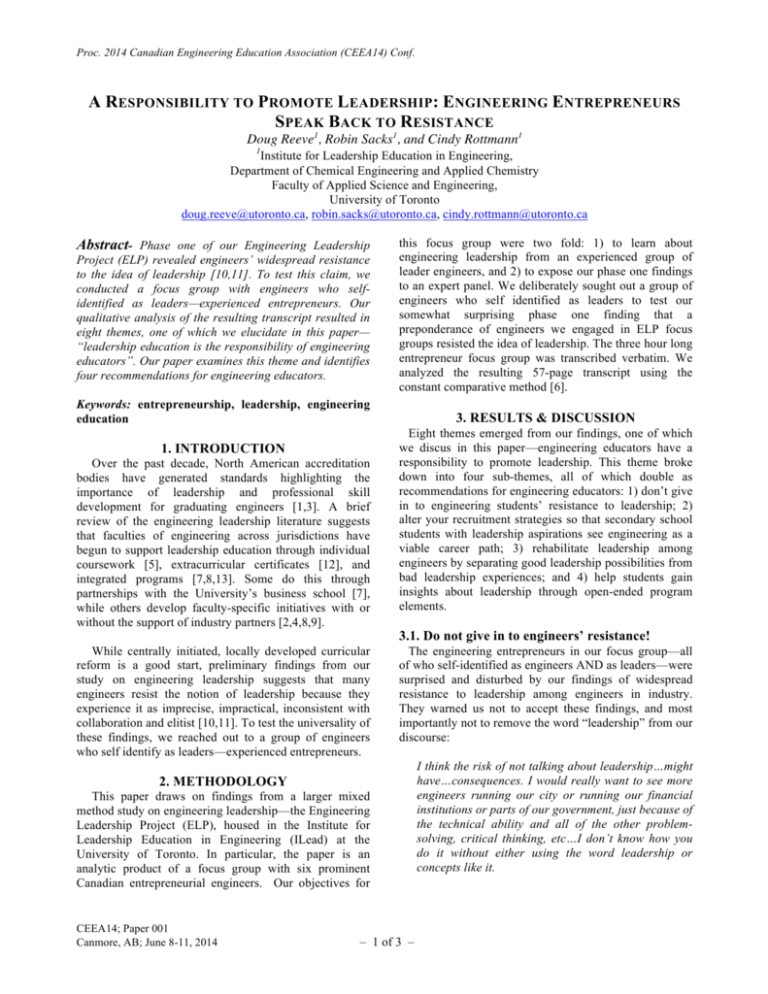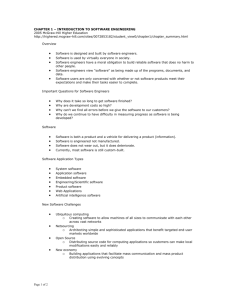Reeve et al, CEEA 2014 final, A responsibility to promote leadership
advertisement

Proc. 2014 Canadian Engineering Education Association (CEEA14) Conf.
A RESPONSIBILITY TO PROMOTE LEADERSHIP: ENGINEERING ENTREPRENEURS
SPEAK BACK TO RESISTANCE
Doug Reeve1, Robin Sacks1, and Cindy Rottmann1
1
Institute for Leadership Education in Engineering,
Department of Chemical Engineering and Applied Chemistry
Faculty of Applied Science and Engineering,
University of Toronto
doug.reeve@utoronto.ca, robin.sacks@utoronto.ca, cindy.rottmann@utoronto.ca
Abstract- Phase one of our Engineering Leadership
Project (ELP) revealed engineers’ widespread resistance
to the idea of leadership [10,11]. To test this claim, we
conducted a focus group with engineers who selfidentified as leaders—experienced entrepreneurs. Our
qualitative analysis of the resulting transcript resulted in
eight themes, one of which we elucidate in this paper—
“leadership education is the responsibility of engineering
educators”. Our paper examines this theme and identifies
four recommendations for engineering educators.
this focus group were two fold: 1) to learn about
engineering leadership from an experienced group of
leader engineers, and 2) to expose our phase one findings
to an expert panel. We deliberately sought out a group of
engineers who self identified as leaders to test our
somewhat surprising phase one finding that a
preponderance of engineers we engaged in ELP focus
groups resisted the idea of leadership. The three hour long
entrepreneur focus group was transcribed verbatim. We
analyzed the resulting 57-page transcript using the
constant comparative method [6].
Keywords: entrepreneurship, leadership, engineering
education
1. INTRODUCTION
Over the past decade, North American accreditation
bodies have generated standards highlighting the
importance of leadership and professional skill
development for graduating engineers [1,3]. A brief
review of the engineering leadership literature suggests
that faculties of engineering across jurisdictions have
begun to support leadership education through individual
coursework [5], extracurricular certificates [12], and
integrated programs [7,8,13]. Some do this through
partnerships with the University’s business school [7],
while others develop faculty-specific initiatives with or
without the support of industry partners [2,4,8,9].
While centrally initiated, locally developed curricular
reform is a good start, preliminary findings from our
study on engineering leadership suggests that many
engineers resist the notion of leadership because they
experience it as imprecise, impractical, inconsistent with
collaboration and elitist [10,11]. To test the universality of
these findings, we reached out to a group of engineers
who self identify as leaders—experienced entrepreneurs.
3. RESULTS & DISCUSSION
Eight themes emerged from our findings, one of which
we discus in this paper—engineering educators have a
responsibility to promote leadership. This theme broke
down into four sub-themes, all of which double as
recommendations for engineering educators: 1) don’t give
in to engineering students’ resistance to leadership; 2)
alter your recruitment strategies so that secondary school
students with leadership aspirations see engineering as a
viable career path; 3) rehabilitate leadership among
engineers by separating good leadership possibilities from
bad leadership experiences; and 4) help students gain
insights about leadership through open-ended program
elements.
3.1. Do not give in to engineers’ resistance!
The engineering entrepreneurs in our focus group—all
of who self-identified as engineers AND as leaders—were
surprised and disturbed by our findings of widespread
resistance to leadership among engineers in industry.
They warned us not to accept these findings, and most
importantly not to remove the word “leadership” from our
discourse:
2. METHODOLOGY
This paper draws on findings from a larger mixed
method study on engineering leadership—the Engineering
Leadership Project (ELP), housed in the Institute for
Leadership Education in Engineering (ILead) at the
University of Toronto. In particular, the paper is an
analytic product of a focus group with six prominent
Canadian entrepreneurial engineers. Our objectives for
CEEA14; Paper 001
Canmore, AB; June 8-11, 2014
– 1 of 3 –
I think the risk of not talking about leadership…might
have…consequences. I would really want to see more
engineers running our city or running our financial
institutions or parts of our government, just because of
the technical ability and all of the other problemsolving, critical thinking, etc…I don’t know how you
do it without either using the word leadership or
concepts like it.
Proc. 2014 Canadian Engineering Education Association (CEEA14) Conf.
Focus group participants trusted our findings, but they
thought it behooved us as educators to intervene for the
good of the students and for the good of society. The next
three sub-themes double as low cost intervention
strategies tied to recruitment, conceptual reframing and
pedagogy.
3.2. Recruit students with leadership aspirations
First, a few of the entrepreneurs encouraged us to visit
local high schools to introduce prospective students to our
leadership initiatives. They believed this recruitment
strategy would help us attract future engineers with
leadership aspirations to the profession. Over time, a less
resistant cohort of engineering students in the faculty
would deflate the collective force behind the persistent
belief that leadership and technical problem solving are
mutually exclusive processes. Members of our team are
currently involved in secondary outreach through
workshops and summer institutes geared at high school
students.
3.3. Reframe & rehabilitate the idea of leadership
Second, a low cost pedagogical strategy for promoting
leadership among students who have already been
admitted to the faculty of engineering is for instructors to
help students reframe and expand their existing
conceptions of leadership:
Here’s the thing. I understand what they are saying.
The concept of leadership sometimes is very broad
and encompassing, but I just think that leadership
doesn’t mean that it is one person sitting on top of the
hill waving a flag. It doesn’t mean that.
The entrepreneurs hypothesized that junior engineers
who distance themselves from the dual engineer-leader
identity might be doing so because of unpleasant
experiences with managers who directed them to
complete repetitive tasks. Our focus group participants
believed that we could rehabilitate the notion of
leadership in the minds of students by helping them gain
insights about leadership from their life experiences with
imperfect leaders while exposing them to positive,
inspirational instances of engineers who lead by example.
Members of our ILead team are currently helping students
reframe and rehabilitate the idea of leadership through
curricular and co-curricular programming, guest lectures,
panels, CEO lunches, infusion lectures and research. In
the coming year, we plan to generate ethical case studies
in collaboration with Canadian engineers across
disciplines to help students hone their decision-making
skills.
3.4. Help students learn from mistakes
The final recommendation that emerged from our
entrepreneur focus group was to create more
CEEA14; Paper 001
Canmore, AB; June 8-11, 2014
experimentation in technical courses and take advantage
of the open-ended nature of existing design courses. This
strategy is less expensive and more manageable than
adding courses to an already packed curriculum, but it
requires a certain level of faculty buy-in. A few
participants who recalled being stifled by repeated
warnings about people dying when engineers made
mistakes stressed the importance of an institutional
climate supportive of open-ended, problem-based
learning. They all thought it was important to allow
students to take risks and make mistakes in a supervised
setting:
Design projects have some version of [learning from
mistakes]…Even if they failed, at least they had an
experience of being confronted by the normal
engineering problem of starting with something fuzzy
and making it real…but this discussion is making me
realize that…giving some tools to help navigate these
[failures], would be a good idea.
The entrepreneur quoted above realized that the
provision of open-ended projects was not enough.
Engineering educators interested in supporting students’
personal and professional growth must also scaffold
student learning through navigation tools and metaanalytic reflection. This pedagogical strategy has been
used by a number of our colleagues who teach elective
courses and run co-curricular leadership certificate
programs, but it has yet to be broadly infused throughout
the curriculum.
4. CONCLUSIONS
Six leader engineers shared important insights with us—
many of which converged on our responsibility to
promote leadership development among undergraduate
engineering students. These prominent Canadian
engineering entrepreneurs diversified our understanding
of the traditional career trajectory for engineers and
energized our work by sharing their agentic philosophies.
It is not enough to describe resistance through illustrative
quotations, as we have done in the first phase of our
Engineering Leadership Project. We also need to actively
oppose it through recruitment efforts directed at future
students, open-ended curricular and co-curricular
offerings for current students, and rehabilitating the idea
of leadership within the engineering profession.
Acknowledgements
This study was conducted with support from four partner
companies. It also received support from the Dean’s
Strategic Fund at the Faculty of Applied Science and
Engineering, University of Toronto. Finally, we are
grateful to the engineers, engineering educators and HR
professionals who agreed to participate in focus groups
and interviews.
– 2 of 3 –
Proc. 2014 Canadian Engineering Education Association (CEEA14) Conf.
References
[1] ABET. Criteria for Accrediting Engineering Programs:
Effective for Reviews during the 2012-2013 Accreditation
Cycle. Baltimore, MD: Engineering Accreditation
Commission (EAC), 2011, 24pp. Available as of April 11,
2014 from
http://www.abet.org/DisplayTemplates/DocsHandbook.aspx
?id=3143
[8] Sherra E Kerns, Richard K. Miller and David V. Kerns.
Designing from a blank slate: The development of the initial
Olin College curriculum. In NAE (Ed.), Educating the
Engineer of 2020: Adapting Engineering Education to the
new century. Washington, DC: National Academies Press,
2005, p.98-113.
[2] David J Bayless, “Developing leadership skills in
engineering students: Foundational approach through
enhancement of self-awareness and interpersonal
communication,” in Proc. CEEA Canadian Engineering
Education Conf., (Montreal, QC; 17-20 June 2013).
[9] Amadin Osagiede, Monica Farmer Cox and Benhamin Ahn,
“Purdue University’s Engineering Leadership Program:
Addressing the shortfall of engineering leadership
education,” in Proc. 120th ASEE Annual Conference and
Exposition, (Atlanta, GA; 23-26 June 2013).
[3] CEAB. Canadian Engineering Accreditation Board
Accreditation Criteria and Procedures. Ottawa, ON:
Canadian Council of Professional Engineers (CCPE), 2012,
114pp. Available as of April 11, 2014 from
http://www.engineerscanada.ca/sites/default/files/w_Accredi
tation_Criteria_Procedures_2012.pdf
[10] Douglas W. Reeve, Robin Sacks, Cindy Rottmann, Frieda
Daniels and Adam Wray, “Engineer leadership in
organizations and the implications for curriculum
development,” in Proc. CEEA Canadian Engineering
Education Conf., (Montreal, QC; 17-20 June 2013).
[4] Elizabeth A Croft, Paul Winkelman, Alaya Boisvert and
Kristin Patten, “Global engineering leadership: Design and
implementation of local and international service learning
curriculum for senior engineering students,” in Proc. CEEA
Canadian Engineering Education Conf., (Montreal, QC; 1720 June 2013).
[5] Greg J Evans, Douglas W. Reeve and Annie E. Simpson,
“Introducing leadership learning in engineering classrooms,”
in Proc. CEEA Canadian Engineering Education Conf.,
(Kingston, ON; 7-9 June 2010).
.
[6] Barney Glaser and Anselm Strauss, The Discovery of
Grounded Theory. Chicago, IL: Aldine, 1967, 271 pp.
{ISBN: 0-202-30260-1}
[11] Cindy Rottmann, Robin Sacks and Douglas W. Reeve,
“Engineering leadership: Grounding leadership theory in
engineers’ professional identities,” Leadership, Currently
under review.
[12] Annie E. Simpson, Douglas W. Reeve and Greg J Evans,
“A summer leadership development program for chemical
engineering students,” Journal of Leadership Education,
vol. 11, no. 1, pp. 222–232, 2012.
[13] Karl K Stevens, Tim VanEpps, Sharon M. Schlossberg,
Ankur Agarwal and Georgiana L Hamza-Lup, “Innovation
leadership honors program: Addressing engineering
education needs through curriculum enhancement,” in Proc.
39th ASEE/IEEE Frontiers in Education Conference, (San
Antonio, TX; 18-21 October 2009).
[7] Amy Hsiao, “Developing engineering managers: The
master of engineering management program at Memorial
University of Newfoundland,” in Proc. CEEA Canadian
Engineering Education Conf., (Montreal, QC; 17-20 June
2013).
CEEA14; Paper 001
Canmore, AB; June 8-11, 2014
– 3 of 3 –








